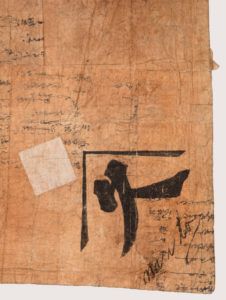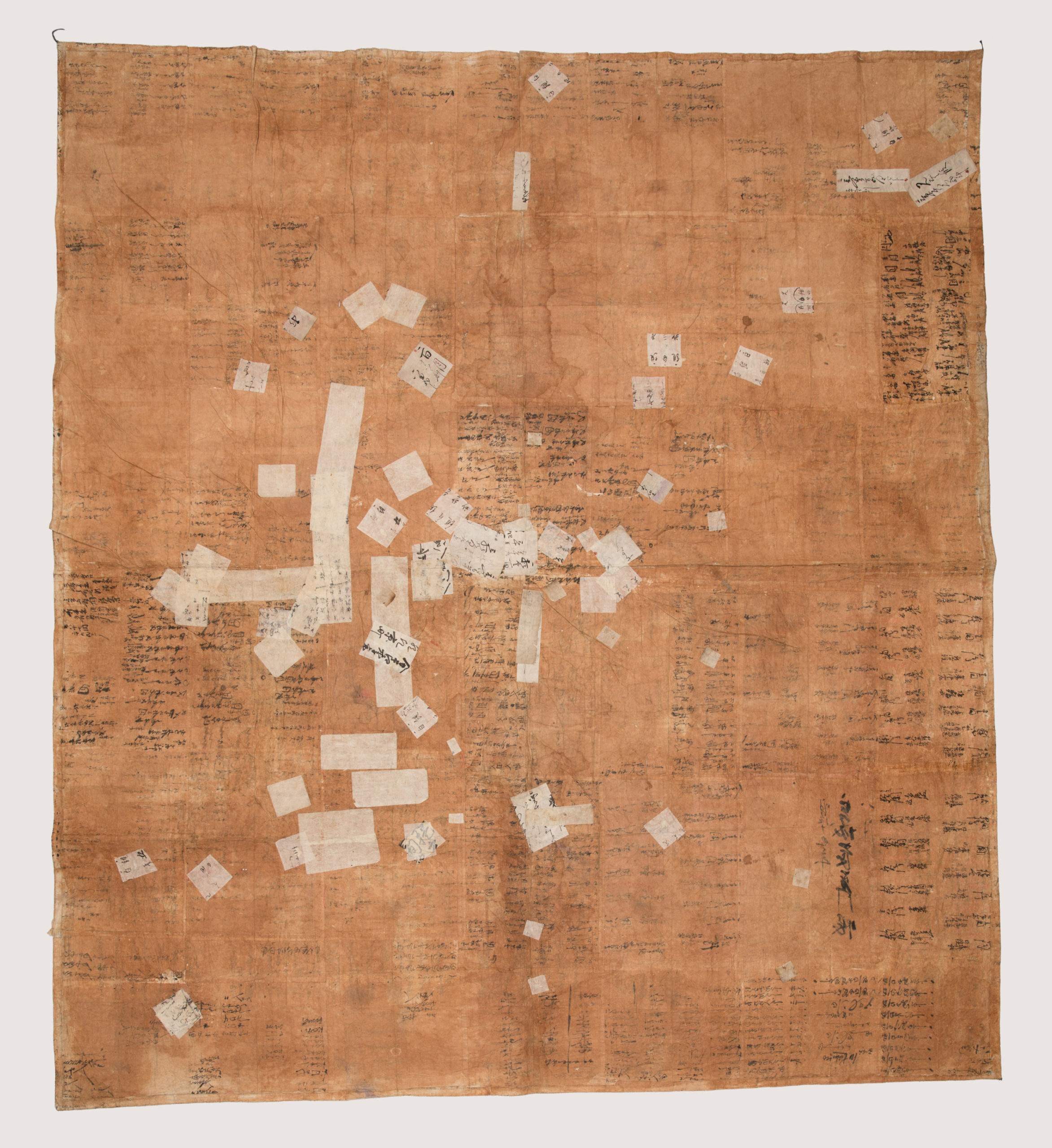September is New York Textile Month, a citywide celebration of textile creativity. As in past years, the museum is collaborating with the Textile Society of America. A non-profit professional organization of scholars, educators, and artists in the field of textiles, TSA provides an international forum for the exchange and dissemination of information about textiles worldwide. Four former presidents of TSA will author Object of the Week posts this month.
Author: Patricia Hickman
The current pandemic has made in-person examination of museum objects impossible, but the photograph alone of this late nineteenth-century Japanese paper furoshiki drew me in. This rectangular wrapper is made of pages of accounting ledgers, cut up and recycled. The paper is washi, made from bast fibers of the paper mulberry tree dyed with unripe, fermented persimmon juice, kaki shibu, which gives it its deep amber color. Random white patches seemingly slapped onto or floating on the surface cover worn spots; presumably the patches are adhered with animal hide glue or rice paste. The sumi ink drawn characters have thick and thin lines and flowing text.
We don’t know how this utilitarian wrapper was used or who used it. Most likely it was a wrapping cloth for a simple bundle at home or a humble cover over a pile of something. Though it looks stiff, the cloth is soft and supple, perhaps from much use, though there is no evidence of wear marks at the corners, as would be expected if the cloth were used to tie and carry bundles. The persimmon tannin makes the paper resilient, strong, and waterproof. The dye deters insects and is anti-mold and mildew.

Corner detail, reverse side.
A bold kanji appears in one corner of the wrapper. The meaning of that character is “a long time”. Time is an ingredient in all aspects of the making of this Japanese wrapper. Sukey Hughes, who has researched the world of Japanese paper, describes a custom wherein paper sheets were placed under a futon on the floor. During the night, the paper absorbed moisture and, as the sleeper turned over, received further massaging and rubbing, contributing to its soft texture. I like to imagine the entire making process that went into this extraordinary, visually sophisticated wrapper, which took place over many years and involved many hands (and sleeping bodies!), and that the wrapper eventually encircled ordinary domestic objects. I look forward to one day seeing this rare furoshiki in Cooper Hewitt’s collection.
Artist Pat Hickman lives and works in the Lower Hudson Valley. Professor Emerita of Art at the University of Hawaii, her gate commission, Nets of Makali’i–Nets of the Pleiades, stands at the Maui Arts & Cultural Center. She is a Fellow of the American Craft Council and serves on the National Basketry Organization Board. Hickman served as President of TSA from 2008-2010.

2 thoughts on “Only Seeing ”
Elena Phipps on September 14, 2020 at 10:39 am
Very mysterious object! Nice to see.
JOHN J. TOOMEY on September 15, 2020 at 6:55 am
Magnificent! In all my years in Japan I never saw such a beautiful paper furoshiki, though I have seen beautiful paper kimonos, worn by poorer classes and even some middle class during Edo and even before, as one often seed in Kabuki Theater. The author is absolutely correct about the seemingly random scattering of the accounting papers, to me almost evoking the look of Tanabata papers tied to bamboo at the Star Lovers’ Festival of Altair and Vega, dancing in the wind. Wishing her great success in this very satisfying pursuit. I hope all will Google the Thai Textile Society website and click in newsletters. I was the founding editor of the Thai Textile Society Newsletter. One of the present editors sent this to me.
When I was teaching at the American Schools in Japan, I always took my students to Ogawa Village in the mountains, where we visited traditional washi mulberry inner-bark paper factories, where they could try their hand at making it. Washi is famously strong and resilient, even moreso when treated with persimmon juice. It is then stiff and strong enough to be cut out into designs for kamigata stencils, used in dyeing kimono and other fabrics. All the best, and thanks for this wonderful article. Keep up the good work, Ms. Hickman! John